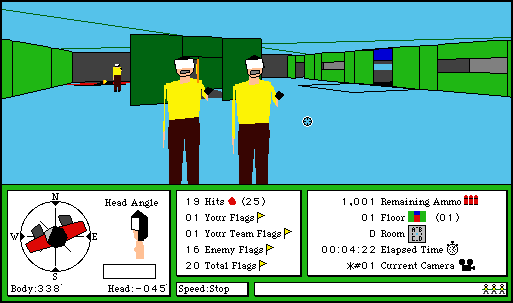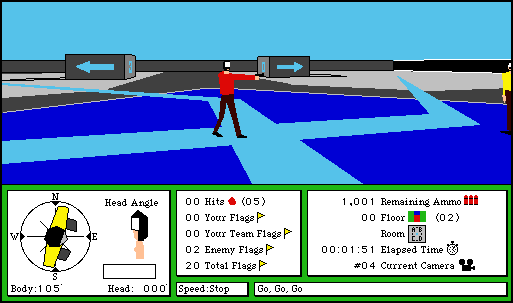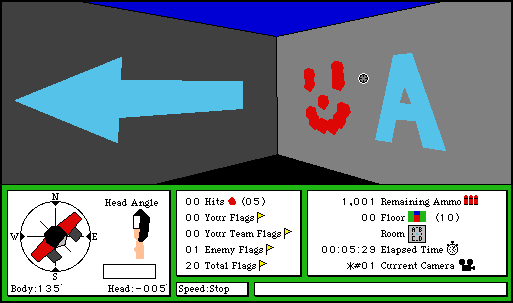Inlägg av Banzeken
Inlägg som Banzeken har skrivit i forumet
Är detta någon sorts maskerad spam?
Haha, jo eftersom det skrevs på engelska kan jag förstå om det verkar lite spam-aktigt. Tanken var nog att nå så många internationella läsare som möjligt om de av någon anledning Googlar efter info kring Trespasser av alla förbaskade spel ;>)
Gammaldags Bump Mapping
Jurassic Park: Trespasser
LOL välkommen till år 1998
The Bump Mapping of Jurassic Park: Trespasser - Per-Pixel Lighting in 1998
The Bump Mapping of Jurassic Park: Trespasser
- Per-Pixel Lighting in 1998
written by BanZeken for FragZone - April 10 2022
With a budget many times over its intended starting capital, Jurassic Park: Trespasser (or just Trespasser for short) was in its time a monstrous undertaking as a game development project. Despite the best of intentions, the team at Dreamworks Interactive had no chance of delivering on all of its PR-statements prior to its release and no way of appeasing expectations arising from said statements. Once the deadline had been set, the team realized that what vision they had in mind for the finished game was not going to make it uncut to the other side. What did make the cut, however, was still nothing short of fascinating, and one of many such fascinating subjects includes its crazy ambition of bringing per-pixel lighting to the masses. This is where Trespasser's use of Bump Mapping comes into play.
The very first raptor you encounter in the game, with Bump Mapping used to represent the scales and wrinkles across its body.
The Bump Mapping of Trespasser is the very first use of true Bump Mapping in a video game. Why "true" and not just in general, you might ask? Well, that has to do with another game in late 1998 that also used Bump Mapping, yet didn't implement it in a form closer to (if not true to) how James F. Blinn had first described its implementation in computer graphics back in the late 1970s, in a paper titled Simulation of Wrinkled Surfaces. To put it very simply and very briefly, Blinn proposed and demonstrated the idea of simulating bumps, wrinkles and creases on 3D surfaces using height values stored in a texture map that represents how the shading of a surface is affected on a per-pixel basis when light from a certain angle hits a curved or a smooth surface with such a texture map applied to it. Doing these kinds of calculations, however, was pretty expensive back in 1978, requiring several minutes to generate each Bump Mapped object (according to Blinn) using the calculations outlined in the paper. Fast-forward to 1998 and consumer-grade processors by this point in time had more than enough computing power to perform such per-pixel texturing calculations in real-time, even if it came at the expense of not being able to filter them and polish them up like a 3D accelerator could without incurring large speed penalties. Unfortunately, graphics cards and 3D accelerators during this time were not designed to perform per-pixel lighting calculations necessary to generate Blinn's wrinkled surfaces. Enter the previously mentioned game; Montezuma's Return.
Video credits goes to 3dfx_Aslinger for the excellent footage of the game using "Voodoo2 Bump Mapping"
The game had first debuted in late 1997 (and according to what documentation can be found online, in Germany exclusively) using only a software-based graphics rendering mode for its 3D graphics, but saw a re-release shortly before Trespasser's late October release in 1998 that incorporated what the game box describes as "Voodoo2 Bump Mapping". The Bump Mapping in question is a computationally cheaper approximation of Blinn's heightmap-based Bump Mapping, called Emboss Bump Mapping. To simply and briefly describe how it works using a real-world example, think of two transparent sheets each containing a printed picture of an identical object on it; one object is colored black and the other is colored white. As you put the sheet with the white object centered on top of the other sheet and slide the top sheet ever so slightly to the side you will start to see the black object shift gradually into view from below the white object, giving the impression of a shadow appearing. This is how Emboss Bump Mapping behaves in motion and just like with the sheet example above, it does not account for the elevation data of individual pixels. Emboss Bump Mapping is thus not able (without looking weird) to fully darken the surface when lit from behind and has a limited range when lit from extreme angles, making it only ideal for completely flat surfaces enclosed in such a way that lights are not able to light it from extreme or obscured angles.
A bump-mapped plant! This is in fact one of the only plants in the game to be bump-mapped and I could only find it in the game's cleverly hidden Test Scene level.
The Bump Mapping in Trespasser, because of its similarities to Blinn's implementation, is able to reproduce fine details on a pixel-by-pixel basis on otherwise unspectacular flat or low-polygonal objects. Combined with the specular highlighting (a different topic) that accompanies some of the bump mapped objects and creatures (see the Brachiosaurus baby in the first level!), the game is capable of displaying surfaces that look both glossy/wet and matte/dry. This level of detail in bump-mapped texturing wouldn't be seen even in games that incorporated DOT3 Bump Mapping (otherwise known as Normal Mapping) early on during the year 2000 (Evolva and Giants: Citizen Kabuto specifically), with games on the original Xbox (2001) like Halo: Combat Evolved giving specular bump-maps another chance to shine. Because of Trespasser's dependency on the processor to generate this effect, however, there are still limitations at play. Firstly, because of the limitation of 3D-capable video cards back then, all multi-textures (which are by nature per-pixel-based in Trespasser) could not have their pixels interpolated using texture filtering; an expensive operation when performed by the processor alone. When running Trespasser using its Direct3D HAL hardware acceleration driver, all texture maps except for the multi-textured ones will be bilinearly filtered, making it easy to at least identify which is which.
Beretta 93r + computer = violently bump-mapped video games!
Here is where things get a little odd. You see, In Trespasser's video settings there exists an option with an accompanying slider called "Brightness". The way brightness usually works in video game settings, you would expect this brightness control to control the actual brightness of the whole image. It turns out, however, that "brightness" in this case ought to be called "shading contrast" instead because that is effectively what the slider controls. The "brightness" slider will by default sit somewhere closer to the middle of the slide bar, with the lowest settings (slider all the way to the left) resulting in the largest contrast; shaded surfaces are at their darkest compared to the lit surfaces, with the right-most slider setting giving the smallest contrast in shading, effectively resulting in uniform lighting across all surfaces regardless of their relation to the sunlight (the game's only source of light). As the slider moves from 0% to 100% this gradually dims the appearance of bump-maps as well.
This picture illustrates how as the "brightness" increases, the bump-maps become harder and harder to spot. This means that players experiencing the game with default brightness values are likely to miss many instances of this effect!
This picture demonstrates what happens at minimum versus maximum brightness value. It effectively disables the Bump Mapping completely, showing how much detail the bump-maps are actually responsible for!
What this in turn results in is something I can only describe as an "unintentional bump-map toggle". Now, OK, it does also have the side effect of disabling the shadow mapping (in Trespasser, it's a uniform method of shadow mapping that only updates when an object moves but is otherwise effectively "un-baked", that is to say generated at runtime) when enough brightness is applied – with extreme settings rendering the shadow mapping in a weird bright tone – but if you go back to my "shading contrast" description, it makes sense why. Both the bump-maps and shadow-maps depend on the contrast between the brightest and darkest point of a scene to make their effect clearly visible to the viewer. When the contrast shrinks, so does the visibility of said maps.
Using the plant from before, it's clear to see how much life bump-maps breathe into an otherwise plain plant texture. Disabling it makes it look like your typical single-texture surface from most games of the time.
This is not to say that every bump-mapped texture in the game was successfully created to account for the benefits Bump Mapping has on giving the illusion of additional geometric detail. Thing is, some textures had light information like shadows and light reflections painted onto the base texture itself. Whilst it does not necessarily mean that the bump-maps will be hard to spot using maximum shading contrast (or minimum "brightness") it does mean that the impact of the bump-map is notably reduced, as the painted-on shadows and lights will override some of the splendor bump-maps can offer. It also means that disabling the bump-maps shows which textures were clearly painted to accommodate bump-maps rather than replace them. This fact is backed up by Richard Wyckoff, a designer who worked on Trespasser, who wrote this for Gamasutra's featured post-mortem of the game: "Many of the bump maps were created by simply converting the original texture to grayscale, an artist’s hack that works for rendered images and animations but not in real-time 3D".
This AK has a texture with lots of painted shadows and light details, resulting in a decidedly unimpressive presence of bump-maps, which are hard to spot among the "baked" shades.
In contrast, this yellow InGen-branded box is an excellent example of how to paint a texture to accommodate the bump-maps which are to be added after. Incredibly granular shading detail is added!
In conclusion: The sheer unhinged ambition in engineering this amount of multi-texturing wizardry in an age still largely dominated by per-triangle shaded and single-textured surfaces (i.e. 1998) can only be commended, even if ultimately spoiled by a low-selling product with extra months of work needed to truly shine. The day Trespasser was left by the roadside following its quick fall from commercial relevance wasn't just a sad day for the team who worked on the game, but a sad day for real-time 3D rendering in general. How much sooner would the world have been introduced to the wonders of per-pixel lighting and shading, not to mention the other technical firsts it had under its belt, if it had not been for the obscurity Trespasser rapidly fell into? All right, enough with the what-ifs, here is now the article to answer the age-old question of "who did actual height-map Bump Mapping first"... until someone comes along and finds evidence of an even older and more obscure game that experimented with Blinn's ideas first. Inevitably. Maybe?
Jag gillar det där uppdraget i Postal 2 när man ska gå till kyrkan för att bekänna sina synder och det bryter ut ett krig mellan präster och jihadister.
Han ser ut som en pajas och låter som en pajas. Ingen sörjer för honom.
The Colony (från '88) på gamla Macintoshdatorer. Förstapersonsskjutare med lättare RPG-element och fokus på utforskande. Låter lite som System Shock när man beskriver det kort, inte sant? Jäkligt intressant rent estetiskt också. Här har man även möjligheten att köra "gaffeltruck" (ser mer ut som en liten mech) vid ett eller två tillfällen och beundras av hur väl dekorerad rymdkolonin är för ett så gammalt "tredimensionellt" spel.
Ett annat intressant Macintosh-spel är Splat'ers (1991); ett tidigt, om inte världens första, paintballspel som också är en förstapersonsskjutare fast med fokus på lagspel. Man kan t.o.m. måla på väggarna med färgen från kulorna. Hur coolt som helst! Man spelar endast med och emot datorer, men är kul ändå då man kan justera ett flertal variabler i options-menyn för att öka eller sänka utmaningen. Innehåller även äkta mouse-look och tangentinställningar (key config) långt innan det var vanligt i denna typ av spel. Kan inte hitta videoklipp på nätet. HardcoreGaming101 har en informativ sida om spelet: http://www.hardcoregaming101.net/splaters/



FMV-sekvenserna i Jedi Knight: Dark Forces II.
/s?
Det behövs en Neverhood- eller SKullmonkeys-film. Man kan aldrig ha för mycket claymation-filmer på marknaden.

Med tanke på vad man kan komma undan med på en rigg från 2007 (med nyare GPU, förstås) så tror jag inte att du behöver oroas av din dators specifikationer.
Den kan se ut som en rosa pyramid med en snurrande discokula på toppen och jag skulle ändå köpa PS5:an om spelbiblioteket är av hög kvalité.
Jag hoppas på att gud spel, inspirerat av Black & White eller dylikt, gör en comeback men med omfattande simulering av fysik -- t.ex. att kunna manipulera stora hav och berg med bara händerna -- och virtuellt mänskligt gruppbeteende -- städer och civilisationer som man kan påverka genom mirakler eller religiöst ledarskap. Vore kul att kunna skapa en egen "syndaflod" och se på när en metropol full av krigande fanatiker slukas av en megatsunami som man själv har vispat upp.
Uppgradera Euphoria. Seriöst talat. Man kan ha kul i timmar endast tack vare Euphoria i GTA4. Varför R* bestämde sig för att handikappa teknologin i 5:an förblir ett mysterium. Jag skulle vara 100% OK med alla förslag i denna tråd så länge Euphoria inte suger i nästa GTA.
Madness Interactive är fan bland dom bästa flashspelen, spelmässigt och tekniskt. Spenderade så jäkla mycket tid med det c:a 2003-2004.
Halo-serien (åtminstone när Bungie var utvecklare) är ju jäkligt känd för sina aggressiva och smarta fiender. Elites är ingenting att leka med!
Jag vill minnas att jag gav namnet Von Braun till en B:-disk innan den slutade fungera. Hmm...
Glöm inte att spela Shadowrun på både SNES och Mega Drive om någon törstar efter lite mer cyberpunk!
Även om det är frestande att nominera TLOU2 eller Uncharted 4, så känner jag att Tokyo Jungle förtjänar en andra chans på PC.